Hypertension is a common condition that may increase the risk of heart disease, stroke, and kidney disease unless it is regularly monitored and managed. Advancements in cellular technology and other communication technologies have made it possible for hospitals and physicians to remotely monitor the patient’s changes in blood pressure, providing more effective and timely care.
A growing body of clinical evidence now supports the view that home blood pressure monitoring (HBPM) offers greater benefits to the patient in comparison to office-based monitoring. Benefits of HBPM may include better management of blood pressure fluctuations, diagnosis and mitigation of white coat hypertension, and more predictive capabilities to estimate the patient’s cardiovascular risk. Moreover, home blood pressure monitoring makes the process more convenient, accessible, and cost-effective than in-office blood pressure measurements.
Emphasizing the need to improve the quality of care for patients with hypertension, Wesley Smith, Ph.D. who is the Co-Founder and Chief Scientific Officer of HealthSnap, said: “Feeling pain, illness, or anxiety are stimuli that influence blood pressure and can complicate clinical decisions. Most patients have at least one of these three when in the clinic. Therefore, the routine monitoring of blood pressure at home should be the standard for evaluating all hypertensive patients in this new age of digital care.”
Limitations of Office-Based Blood Pressure Measurement
Data from primary care facilities as well as clinical trials show significant variations in office-based blood pressure measurements. A research study involving multiple BP readings performed over a period of two weeks under controlled conditions revealed variability to the extent of 30 mmHg, with no changes to the patient’s treatment.
Another observational study involved 10 participants whose BP was measured by primary care doctors. Right after the readings were performed by the doctors, two research assistants trained in BP measurement were asked to repeat the readings. A few weeks later, the research team repeated the same process on the 10 volunteers.
The measurements performed by the doctors were compared with the measurements done by the trained research assistants. The mean differences in readings at baseline between the doctors and the assistants were as follows: Systolic: 23 mmHg and Diastolic: 15.3 mmHg.
Even after the primary care doctors were trained for BP measurement, the mean difference in readings continued to be significantly high as follows: Group A: 25.3 mmHg & 17.0 mmHg; and Group B: 22.3 mmHg and 14.4 mmHg. As a consequence of the inaccuracies in blood pressure readings, 24 to 32 percent of the study participants were wrongly diagnosed as having systolic hypertension, while 15 to 21 percent were misdiagnosed as having diastolic hypertension.
Advantages of Home Blood Pressure Monitoring (HBPM)
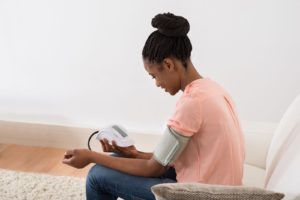
Out-of-office BP measurement can be performed using two types of technologies: Self-measured Ambulatory Blood Pressure Monitoring (SMBP) or 24-hour Ambulatory BP Monitoring; and HBPM or Home BP Monitoring. In both of these technologies, multiple BP measurements are considered more reliable and more reproducible. At the same time, these technologies also allow for nocturnal BP measurement, which enables doctors to detect BP fluctuations during the night.
However, ABPM technology is expensive and not considered a practical option for long-term BP monitoring. Self-measured blood pressure monitoring, on the other hand, has emerged as the gold standard for hypertension screening in recent years. It is easy to use, more accurate, and cost-effective. Non-invasive approaches to blood pressure measurement include tonometric, oscillometric, auscultatory, and pulse waves.
The technology and principle behind SMBP and ABMP monitors are the same, but self-measured blood pressure monitoring gives the patient the freedom to monitor their blood pressure as frequently as they want. While ABPM devices provide BP readings at multiple points of time during a routine day, HBPM monitors obtain BP information at fixed time intervals and under specific conditions over an extended time period.
Therefore, HBPM provides comparatively more stable measurements with a high degree of reproducibility. In terms of reliability, HBPM has been shown to be equivalent to ABPM. The advantages of Home-Based Blood Pressure Monitoring may be summarized as follows:
- Multiple BP readings can be obtained over a long time period
- Eliminates the white coat reaction to blood pressure readings
- Results are highly reproducible
- Improved predictability of cardiovascular morbidity & mortality compared to office-based BP measurement
- Detects white coat as well as masked hypertension
- Identifies increased variations in blood pressure
- Medical professionals can perform telemonitoring using remote patient monitoring (RPM) devices
- Patients have a better opportunity to understand the importance of hypertension management
American Heart Association Guidelines for the Use of HBPM
According to the latest recommendations of the American Heart Association (AHA), BP readings obtained through home monitors (which are usually oscillometric devices) could be more accurate predictors of cardiovascular morbidity compared to BP readings in a clinical setting. The recommendations go on to say that a growing body of evidence also indicates that home BP readings improve the predictability of organ damage.
HBPM for older patients may support doctors in determining antihypertensive medication dosage. Moreover, electronic home BP monitoring is cost-effective, easy to use, and could improve patient compliance, according to the AHA. Self-monitoring usage recommendations from the AHA include:
- The patient should comfortably sit for about 3 to 5 minutes with the upper arm raised to the heart level prior to taking a BP reading.
- The patient should not eat or exercise right before the BP measurement.
- Three measurements should be obtained at intervals of at least one minute, and the average value of these readings should be recorded.
- Readings taken in the early morning and evening are particularly helpful.
- The upper limit for blood pressure is 135/85 mmHg (according to the American Society of Hypertension).
- HBPM devices with printouts or memory are recommended, considering the potential for inaccurate reporting to the doctor.
- The AHA recommends a lower home BP goal for patients with diabetes, kidney disease, and pregnant women, among others.
Accuracy and Reproducibility of HBPM
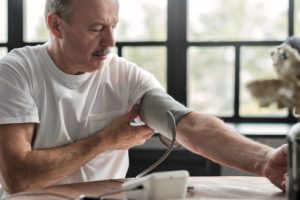
A study published in Nature journal showed that BP readings with Home Based Blood Pressure Monitoring are usually lower than the measurements taken in an office setting and are closer to the blood pressure measurements recorded on average during 24-hour ABPM. With the use of HBPM, it is possible to record a higher number of readings and provide more reproducible measurements compared to office BP readings. In addition, HBPM enables better correlation with the parameters of target organ damage.
A clinical trial retrospective analysis compared the variability between patients related to different BP measurement approaches over a period of six weeks. The analysis showed the following coefficients of variation:
- Office Blood Pressure Monitoring: 8.6%
- 24-Hour Ambulatory BP Monitoring: 5.5%
- Home Blood Pressure Monitoring: 4.2%
Researchers concluded that HBPM used for one week was the most accurate BP measurement method. Another research study showed that HBPM has a higher reproducibility in comparison to both ABPM and office readings.
White Coat Hypertension and Masked Hypertension
White Coat Hypertension (WCH) describes a condition where the blood pressure readings of an untreated patient turn out to be higher at their physician’s office, while the BP levels are normal outside the medical office environment. This condition is also termed isolated clinical hypertension. The increase in the BP level that occurs in an office setting is defined as the white coat effect.
Patients that present a blood pressure reading higher by at least 20 mmHg (systolic) and/or 10 mmHg (diastolic) compared to ambulatory BP measurements are considered to have a significant level of white coat effect. Owing to the white coat effect, treated patients who are detected with uncontrolled blood pressure in an office setting, but have normal BP values otherwise may be designated as false-resistant or pseudo-resistant hypertensives. This condition is also called office-resistant BP control.
Masked Hypertension (MH), on the other hand, describes a condition where an untreated patient presents with normal blood pressure in an office environment (generally less than 140/90) while showing elevated levels of BP during home blood pressure monitoring (generally higher than 135/86 mmHg during daytime.) In the case of patients who have been treated for hypertension, this condition may be described as masked uncontrolled hypertension (MUCH).
Patients with white coat hypertension face the risk of being medically managed as actual hypertensives, receiving overtreatment, and undergoing lab tests. Similarly, patients with masked hypertension face the risk of under-diagnosis and under-treatment. As many as one in three office-managed patients may have white coat hypertension or masked hypertension, which underscores the importance of home blood pressure monitoring methods to mitigate the chances of patient misclassification.
Home-based blood pressure monitoring offers the advantage of measurements being taken in a relatively relaxed and familiar environment. Patients widely accept self-measurement for the reasons of ease of use, time-saving, and cost-effectiveness. As a result, more active patient participation is seen in the management of hypertension when home blood pressure measurements are used.
In contrast with traditional office BP readings, HBPM allows for a higher number of measurements to be taken, minimizes measurement error and observer bias, and eliminates the white coat effect. All these factors contribute to improvements in diagnostic accuracy. Based on the more reliable HBPM readings, adjustments in antihypertensive drugs may also bring down healthcare costs. These are some of the key advantages of HBPM methodology over and above its ability to target blood pressure variability more effectively for better patient outcomes.
Research Study Finds Correlation between Masked Hypertension and Stroke
Can masked hypertension (MH) lead to a higher risk of stroke? A cohort study involving 4,261 patients found that the patient group with MH had an increased risk of stroke than the patient group with controlled BP levels, independent of conventional CV risk factors. The study participants were classified into 4 blood pressure groups:
- Masked hypertension – non-hypertensive office BP levels and hypertensive home BP levels
- Whitecoat hypertension – hypertensive office BP levels and non-hypertensive home BP levels
- Sustained hypertension – hypertensive office and home BP levels
- Controlled blood pressure – non-hypertensive office and home BP levels
The participants were treated on an outpatient basis at 71 university hospitals or primary care practices. They underwent office BP measurements twice, apart from HBPM readings in the mornings & evenings over a two-week period. Researchers analyzed the data from 1st July 2017 to 31st October 2017.
During a median follow-up period of 3.9 years, 74 stroke events occurred. Researchers found that the masked hypertension patient group had a higher risk of stroke in comparison to the controlled blood pressure group. The hazard ratio (how often the stroke event occurred in one group compared to the other) was determined to be 2.77.
The researchers concluded that the use of Home Blood Pressure Monitoring may improve the evaluation of hypertension-related risks and help identify more effective therapeutic interventions designed to prevent or minimize cardiovascular disease events.
Which BP Measurement is the Most Reliable Predictor of Cardiovascular Outcomes?
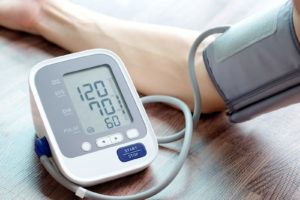
Hypertension is recognized as the world’s number one risk factor for CVD (cardiovascular disease), and it predicts an estimated 1,000 deaths every day. Clearly, the diagnosis, as well as the management of hypertension, is heavily dependent on the accuracy of blood pressure measurement.
According to a research article published in the Journal of the American College of Cardiology, a large majority of scientific evidence is available on the safety and efficacy of antihypertensives in clinical trials, and home blood pressure monitoring (non-office BP measurement) is now the recommended method for hypertension diagnosis and management.
One of the key reasons is that HBPM helps in the detection of white coat syndrome and masked hypertension in individuals not taking antihypertensive medications as well as masked uncontrolled hypertension and white coat effect in patients using antihypertensive therapy. While white coat hypertension (WCH) is linked with some excessive risk of cardiovascular disease, masked hypertension has been associated with detrimental CVD outcomes quite similar to those seen in patients with sustained hypertension.
BP measurements with home blood pressure monitoring have a strong association with clinical cardiovascular outcomes and target organ damage (hypertension-related). The Journal cites a cohort study to show the predictive value and reliability of blood pressure measurements at the office, through ABMP, and at home (HBPM) on the left ventricular mass index or LVMI.
The participants in the study were relatively young (41.2 years mean age) and did not include patients with severe hypertension or those taking antihypertensive drugs. The results of the study surprisingly showed that HBPM was the strongest linkage with LVMI and had the highest reliability among the three BP reading methods. The results continued to be significant after making adjustments for the participants’ age, gender, ethnicity, diabetes, and body mass index, among other modalities.
LVMI is considered a valid measure of cardiovascular disease risk stratification and is a recognized marker for heart disease (subclinical). A considerable increase in LVMI indicates left ventricular hypertrophy (LVH) and remodeling, which is a form of cardiovascular target organ damage. LVH is considered an independent risk factor for cardiovascular disease morbidity and mortality as well as an indicator of sustained patient exposure to elevated blood pressure over a period of time. LVH is also a risk factor for ventricular and atrial arrhythmias, myocardial ischemia, heart failure, dementia, and cerebrovascular disease.
According to the JACC article, ABPM in the US is largely inaccessible to primary care physicians, who are actually managing most of the patients with hypertension. It is rarely used and inadequately reimbursed. Therefore, the evidence that HBPM relates more closely than ABPM with LVMI and is more reliable can be potentially transformative for clinical practice.
Home blood pressure monitoring delivers a different dataset than ABPM. While ABPM measures daytime dynamic blood pressure, including momentary variations caused by postprandial, postural, and medication-induced changes in BP levels, HBPM measures daytime resting blood pressure. The results of the study cited in the JACC article demonstrate that measuring daytime resting BP might be more significant than daytime dynamic parameters when it comes to predicting cardiac target organ damage.
While more research is needed in this area, the current study indicates that HBPM may be particularly vital for the detection of hypertension and elevated blood pressure levels early in life, when individuals are relatively healthy but have a higher lifetime risk of cardiovascular disease due to hypertension.
Considering the growing stress on the healthcare system, cost-effectiveness, prudent time management, and resource optimization in the diagnosis and management of hypertension are practically important considerations. Utilization of ABPM involves higher costs, use of advanced equipment, a longer time for interpretation, and more knowledgeable teams compared to HBPM.
Moreover, when patient instructions and tasks are simplified, it improves compliance and helps enhance the doctor-patient relationship. In the cited cohort study in the JACC article, the participants who performed HBPM had received only an instruction sheet plus five minutes of in-office training (recognizing the practical constraints of modern clinical practice), and HBPM was conducted just for one week.
And yet, the study results demonstrated the strongest association with cardio target organ damage and the highest degree of reliability compared to other tested modalities. The authors of the JACC articles conclude that subject to confirmation, the study findings encourage the implementation of home blood pressure monitoring as the preferred modality for non-office BP measurement.
More Effective Management of Hypertension with HBPM
Different ways to measure and monitor BP response in a patient could clinically influence a care provider’s treatment decisions. A research meta-analysis of over 6,000 patients showed that when measured with HBPM, the antihypertensive response of patients to drug therapy was 20% lower than office BP measurements.
Another clinical study showed that in terms of assessing the patients’ BP response to hydrochlorothiazide and atenolol (antihypertensive agents) was similar between HBPM and 24-hour ABPM. However, office BP readings over-estimated the blood pressure response in comparison to HBPM – showing a higher reduction in systolic blood pressure of 4.6 mmHg and a higher reduction in diastolic BP of 2.1 mmHg across various drug therapies.
These study findings suggest that HBPM could improve hypertension management decisions, especially considering the relative ease of including HBPM in the patients’ daily routine. BP control may improve in patients who have uncontrolled hypertension when HBPM multiple readings are incorporated into routine patient management.
Numerous other meta-analyses and studies have demonstrated that in comparison to standard office care, the use of HBPM may be associated with considerable lowering of systolic and diastolic blood pressure as well as a reduction in the use of antihypertensive medication therapies and therapeutic inertia (failure to adjust medication despite elevated levels of BP).
Although a majority of clinical studies until now have focused primarily on white populations, a few studies have focused on ethnically diverse groups with uncontrolled BP as well as high-risk patients (who have a history of coronary heart disease, stroke, chronic kidney disease, diabetes, and with a baseline blood pressure level of 130/90 mmHg or higher). These studies have also covered patients from medically underserved, low-income communities.
HBPM Combined with Telemonitoring for Greater Effectiveness
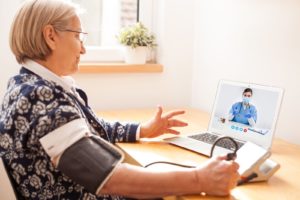
Home blood pressure monitoring is considered most effective when it is accompanied by telemonitoring (input from a medical professional). Using remote patient monitoring (RPM) technologies, BP readings taken at home are relayed in real-time to a primary care practitioner who can provide timely treatment guidance in a way that the prescribed treatment is impacted by the BP measurements obtained more directly.
A number of research studies have supported the utilization of HBPM in conjunction with telemonitoring. One of the key differences with remote patient monitoring technology is that it avoids the need for the patient to travel as well as saves the healthcare provider’s time.
Hypotheses also suggest that when patients have a better understanding of their own blood pressure changes and recognize the impact of therapy more directly, it increases their likelihood of compliance with the treatment over the long term, even when the drug therapy may not seem to immediately make them feel better. Some research studies have also indicated that drug therapy adherence in patients with hypertension improves with HBPM.
HBPM is More Cost-Effective than Other BP Measurement Modalities
Researchers have performed a cost-benefit analysis, which demonstrated that home blood pressure monitoring is not only more effective in the diagnosis & management of hypertension compared to office BP monitoring, but it is also simpler to perform and involves less investment of capital and labor compared to ABPM.
Researchers used a decision-analytic model to carry out a cost-benefit analysis for HBPM from the insurers’ perspective. The data inputs for the model were taken from the insurance claims figures from 2008 to 2011 of a US private insurance company, and from data collected between 2009 and 2010 by the National Health & Nutrition Examination Survey, apart from various meta-analyses published.
The model took into account different stages a patient may go through from initial visit to the doctor to diagnosis of hypertension to drug therapies and other treatments to cardiovascular disease resulting from hypertension, and resignation from the treatment plan or patient death.
The model was used to estimate HBPM cost-benefit ratios as well as short-term and long-term return on investment (ROI) for HBPM in comparison to office BP monitoring. The results of the analysis indicated that from an insurance company’s perspective, reimbursement of HBPM is more cost-effective (savings) and cost-beneficial (returns on investment) for the diagnosis and treatment of hypertension.
Joint Scientific Statement on the Use of Home Blood Pressure Monitoring
Looking at the established benefits of HBPM for patients, healthcare providers, insurers, and other stakeholders, the American Heart Association (AHA), the American Society of Hypertension (ASH), and the Preventive Cardiovascular Nurses Association (PCNA) issued a joint scientific statement to suggest that home blood pressure monitoring should be incorporated into patient care.
According to this statement, HBPM is easier to perform as well as cheaper than ABPM (ambulatory BP monitoring) and overcomes various limitations of the conventional office BP measurement. BP monitors based on oscillometric technology available at present are easy to use, reliable, accurate, and relatively affordable. A growing number of patients are now regularly using these devices to check their blood pressure levels at home.
While the use of HBPM has been endorsed by various national and international organizations, comprehensive recommendations on the usage have been lacking. Research increasingly shows that home-based blood pressure readings taken by patients are often found to be lower than the office BP measurements and are closer to the 24-hour ABPM readings, which are the best predictor of cardiovascular disease risk.
Considering the greater number of BP readings with HBPM than what can be taken in the office as well as the removal of the white coat effect, at-home BP measurements are more reproducible and demonstrate a stronger association with measures of cardiovascular target organ damage. Moreover, prospective research studies that have utilized home BP measurements to express the true blood pressure levels have shown that home BP is a better predictor of cardiovascular risk compared to office BP.
The joint scientific statement made the following recommendations for the use of HBPM:
- It is recommended that home blood pressure monitoring should be incorporated as a routine element in BP monitoring in the majority of patients who have confirmed or suspected hypertension.
- Buying oscillometric monitors should be advised to patients. These are devices that measure blood pressure on the upper arm using an appropriate cuff size. The devices should be proven for accuracy according to established protocols. Healthcare professionals should show patients how to use the home blood pressure monitor correctly.
- Two to three BP readings should be taken both in the morning and evening over a one-week period, and the readings should be performed when the patient is resting in a seated position. At least 12 readings should be used for making therapeutic decisions.
- Home blood pressure monitoring is indicated in patients who have been newly diagnosed with hypertension or are suspected to have hypertension, where HPBM may differentiate between sustained and white coat hypertension. In case the results are equivocal, ABPM may help in determining the diagnosis.
- Pre-hypertensive patients may benefit from HBPM because it can detect masked hypertension.
- It is recommended to use HBPM for assessing the response of any form of antihypertensive therapy and it may improve patient compliance.
- The goal of HBPM treatment in high-risk patients is less than 135/85 mmHg or 130/80 mmHg.
- Home blood pressure monitoring is beneficial for older patients, in whom the white coat effect and BP variability have increased.
- HBPM offers useful value for diabetes patients in whom careful BP control is of prime importance.
- HBPM may benefit other populations, such as patients with chronic kidney disease (CKD), pregnant women, and children.
- Home blood pressure monitoring has the potential to enhance the quality of care while lowering the associated costs and it should be reimbursed.
Variability in Blood Pressure Levels Detected with HBPM
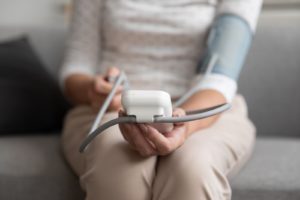
According to a research article published in Nature, blood pressure variability phenotypes include:
- Morning hypertension
- Evening hypertension
- Nocturnal hypertension
- Nocturnal dipping
- Morning surge
Considering the significant BP white coat effect on in-office BP measurements, researchers have increasingly focused on BP variability factors in ABPM and HBPM as the readings are found to be more reliable and any clinical variability in day-to-day readings may be predictive of cardiovascular risks.
A study cited in the Nature article shows that day-to-day BP variability when HBPM modality was used was predictive of stroke. Other studies have also demonstrated that higher variability in morning blood pressure levels in the case of HBPM is an independent predictor of potential cardiovascular events. Studies have confirmed the predictive value of day-to-day HBP variability for hypertensive target organ damage. Some researchers emphasize that home blood pressure monitoring can provide short-term BP variability data, which can be predictive of total and non-fatal CV events and mortality.
At the same time, HBPM is also a reliable method to detect BP variations over the long term, including seasonal BP variations. Researchers cited in the Nature article say that HBPM captured minimal seasonal BP changes in patients with borderline hypertension. HBPM-defined seasonal BP variations have been extensively reported under different pathophysiological conditions.
Morning BP Levels and Morning Hypertension
The Nature article cites studies, which show that ABPM measurements in the morning (right after waking up) are unstable because during this period the patient may find it hard to keep their arm motionless. Therefore, BP readings in this time period are often inaccurate using ABPM.
In the case of HBPM, the blood pressure levels are measured at fixed hours of the day under fixed conditions. Therefore, morning BP readings using HBPM averaged over an extended time period are reproducible and reliable.
Morning BP readings with HBPM have prognostic significance, as reported by studies cited in the Nature article. These studies have shown that morning hypertension (hypertension observed specifically in the morning) could be a greater predictor of stroke compared to evening hypertension, especially in patients who are taking antihypertensive drugs.
Hypertension in the morning may be mediated by a morning surge or may be noticed following nocturnal hypertension or non-dipper/riser hypertension. Morning BP has predictive value for cardio target organ damage as confirmed by researchers. HBPM differences in morning/evening readings are one of the key indicators of morning hypertension or high morning BP.
Studies cited in the Nature article have demonstrated that the higher the difference between morning and evening BP readings, the greater may be the cardiovascular mortality.
Evening BP Levels and Evening Hypertension
Based on HBPM, evening blood pressure levels are affected by the patient’s mental and physical activities and lifestyle choices, such as walking, bathing, alcohol consumption, and the evening meal. Evening BP readings are also impacted when the patient is taking antihypertensive medications in the evening.
According to the hypertension practice guidelines issued by the Japanese Society of Hypertension, as cited in the Nature article, morning HBPM should be measured within one hour after awaking, after urination, and prior to breakfast and ingestion of medications. The guidelines also say that evening HBPM reading should be taken once just before retiring to bed.
The researchers found that evening home blood pressure levels in Japanese patients were lower than in the morning HBPM. However, in Caucasian populations, researchers have reported that evening HBPM blood pressure measured levels are higher than the morning HBPM. Differences in lifestyles may mediate this difference.
Nocturnal BP Levels and the Morning Surge
Based on ABPM, nocturnal BP readings and nocturnal BP dipping status have poor reproducibility because the quantity, as well as quality of nocturnal sleep, impacts the nocturnal BP levels. Moreover, the morning surge observed with the difference between morning and nocturnal blood pressure levels on the basis of the ABPM method is not reproducible, according to studies cited in the Nature article.
Considering the established prognostic value of nocturnal BP, its accurate evaluation is of significant clinical relevance. In the Japanese study cited in the Nature article, the researchers built an HBPM device that could monitor nocturnal BP while the patient was asleep. These types of devices are now used in clinical pharmacology studies, extensive intervention trials, and epidemiological surveys.
HBPM can repeatedly assess nocturnal BP, but it is usually measured using an HBPM device only a limited number of times while the patient is asleep. Patients are able to recall whether they woke up at the time of the measurements. On the other hand, ABPM takes BP measurements during the night every 30 to 60 minutes, and the patients usually don’t remember whether they woke up when the measurements were taken.
With HBPM devices, it is now possible to assess the correlation between nocturnal blood pressure levels and the patient’s quality of sleep. Nocturnal HBPM along with morning and evening BP measurements with HBPM over an extended time period may provide useful information on the nocturnal BP dipping status.
BP Measurements are More Accurate at Home than a Clinic: Kaiser Permanente Study
According to a new research study led by investigators from Kaiser Permanente, BP readings routinely taken at home have a greater likelihood of providing the basis for a more accurate hypertension diagnosis compared to a clinic setting. This is the finding from randomized controlled trials involving 510 adults that visited the primary care centers of Kaiser Permanente in Western Washington from 2017 to 2019.
The study was published on March 3, 2022, in the Journal of General Internal Medicine. The first author of the study, Dr. Beverly B. Green, said that BP varies significantly over the course of a day – roughly 30 mmHg systolic. Therefore, just one or two readings in the clinic might not be truly representative of your average blood pressure levels. Home blood pressure monitoring (HBPM) enables you to obtain many more measurements and take an average of those, Dr. Green said.
To carry out the study, the researchers used EHRs to identify potential adult participants that had a high risk of hypertension. The participants were randomly divided into three groups based on the modality used for obtaining BP readings: in the office, at home, or at the kiosks in healthcare clinics or pharmacies.
Additionally, each participant received a 24-hour ABPM to confirm a new hypertension diagnosis. Ambulatory Blood Pressure Monitoring or ABPM makes use of a full upper arm cuff that is connected to a device on the waist, worn for 24 hours continuously. The device is activated every 20 to 30 minutes in the daytime and every 30 to 60 minutes during sleep.
The research team compared the ABPM results with the other three methods to determine their accuracy. The findings were as follows:
- HBPM measurements (at-home readings) were consistent with ABPM.
- BP measurements based on clinic visits were significantly lower for systolic, resulting in more than 50% of the participants with hypertension (diagnosed with ABPM) getting missed out.
- BP measurements from kiosks were significantly higher compared to the ABPM readings, leading to an increased likelihood of hypertension over-diagnosis.
According to Dr. Green, HBPM was a superior option because of its higher accuracy compared to the office BP readings. In addition, a companion research study demonstrated that patients had a preference for taking blood pressure readings at home. The findings of the companion study were presented at a Hypertension meeting of the American Heart Association.
According to Kaiser Permanente, millions of Americans may be living with undiagnosed hypertension. An analysis published recently in JAMA indicated that nearly one in four US adults was unaware that they had high blood pressure and were not undergoing treatment.
Correct hypertension diagnosis can save lives. In absence of treatment, hypertension can lead to stroke, heart attack, kidney damage, and other life-threatening conditions. Current hypertension diagnosis guidelines suggest that patients with in-clinic high BP readings should undergo another type of test to confirm the findings, such as HBPM or ABPM methods.
Although studies in the past have demonstrated similar benefits of HBPM, the latest Kaiser Permanente study may offer the strongest evidence until now because of its fairly large number of subjects, its use of real-world medical professionals to take BP readings instead of research professionals, and its involvement of 12 primary care clinics. Moreover, this is the first study to compare the ABPM and kiosk results.
Home Blood Pressure Remote Monitoring in the 21st Century
Technological advancements in the field of communication have paved the way for newer and more effective approaches to home blood pressure monitoring (HBPM), such as remote patient monitoring (RPM). Telemonitoring delivered through cell phones is one of the most impactful interventions that can reach more people in an easy, reliable, and affordable manner. RPM for BP monitoring can significantly improve the quality of hypertension diagnosis and management.
RPM for home BP monitoring can empower hypertension patients with more information, encourage adherence to antihypertensive drug therapies, enable more productive patient-physician relationships, and most importantly, improve cardiovascular risk control.
Thanks to the RPM cellular technology, medical professionals can track the patient’s BP status in real-time outside of the clinic, and make timely interventions. This can be a lifesaving feature of remote patient monitoring technology, particularly for patients with sudden BP rises or acute symptoms.
A number of BP telemonitoring (BPT) technologies and home blood pressure monitors are available today, which are distinguished by the different modes of data collection and transmission. The connected blood pressure measuring devices are also differentiated by add-on features and services, such as reminders for BP readings to be performed, reminders for medication intake, and automated reporting of the data.
In BP telemonitoring or BP remote patient monitoring solutions, the BP readings are recorded in the memory of the device and transmitted periodically or in real-time to a remote host. Cellular technology, which has emerged as the most dependable solution for remote BP monitoring, achieves data transmission through a cellular network while applying data encryption protocols to ensure privacy and security.
Once the data is received by the remote host, it is stored and analyzed and reports are generated automatically. In general, a case manager (such as a nurse or healthcare technician) may first review the BP measurement report before it is submitted to the designated doctor. Thereafter, the doctor may prescribe or adjust medications, recommend a visit to the clinic or hospital for further evaluation, refer to a PCP, or arrange emergency care if needed.
Benefits of Cellular Remote Patient Monitoring Technology in Hypertension Management
The explosive growth in cell phone communication technology has led to the widespread use of connected health devices and apps. A survey in the US revealed that 52 percent of smartphone owners make use of their cell phones to look for health-related information. Benefits of cellular RPM technology in the monitoring and management of hypertension include:
Health Benefits
- More accurate diagnosis of hypertension, while eliminating or minimizing the concerns related to the white coat effect and masked hypertension
- Improved hypertension management with greater control over health status and risk factors, especially for patients with acute BP symptoms
- Increased doctor-patient communication, improvement in adherence to medications, and mitigation of treatment inertia
- Better patient education and understanding of BP management, leading to proactive patient compliance
- Patient empowerment through the promotion of at-home management and greater patient participation in healthcare decision making
Practical Benefits
- Hypertension treatment access to patients from under-served communities or those that cannot be reached through computer-based communication
- Cell phones are always in use, but computers are not – which ensures better connectivity and communication
- The use of cellular RPM devices for BP monitoring requires almost no technological literacy or training on part of the patient
- Communication reliability and low cellular network maintenance and downtime
- Significant cost savings for the patients and care providers as well as an overall reduction in the burden on the healthcare system
The available evidence suggests that BP remote patient monitoring through cellular devices may be more effective in achieving greater control over blood pressure levels in hypertensive patients. It may also support healthcare providers to serve a larger number of patients more efficiently and follow up more closely with patients that require tighter BP control.
Cellular remote monitoring devices for BP monitoring are widely accepted by patients because the technology reduces their need for travel and face-to-face consultations, cuts down their medical costs, optimizes antihypertensive therapies, and leads to an overall improvement in the patient’s quality of life.
Role of RPM Devices in the Management of Cardiovascular Disease
Remote Patient Monitoring (RPM) using cellular RPM devices has a crucial role to play in the management of cardiovascular disease (CVD) and in the improvement of patient outcomes. Appropriate use of RPM cellular devices for BP monitoring can help lower blood pressure levels, enable early detection of arrhythmia, and predict heart failure decompensation to support timely medical interventions.
More than 120 million US adults suffer from heart disease today, and many more have a significant lifetime risk of developing this condition. Considering the pervasiveness of the disease and recognizing the prevention potential with early diagnosis and management of hypertension, it is vital to implement cellular RPM BP monitoring at scale. This can enable patients with hypertension to live longer and healthier lives while lowering the incidence of morbidity and mortality.
Hypertension
Beyond the established benefits of home self-measured blood pressure, RPM with a BP cuff can work more effectively to manage hypertension. With the use of RPM for BP monitoring, patients have a greater likelihood of achieving better control over both systolic and diastolic measures of BP.
Research published in the Hypertension journal showed that improved patient-physician engagement and appropriate antihypertensive drugs in accordance with the RPM readings can deliver better patient outcomes. Another study published in Clinical Cardiology found that 91 percent of patients maintaining a weekly remote BP monitoring protocol were able to reach a target blood pressure level of below 135/85 mmHg within seven weeks of the program on average.
Apart from being a useful modality to track patients with a confirmed hypertension diagnosis, RPM is also effective as a preventative solution to delay, halt or reverse the patient’s condition from worsening to hypertension. The convenience and ease of use of cellular RPM home blood pressure monitors have also made it an effective method to track gestational hypertension.
Heart Failure
While portable RPM devices for BP monitoring are widely accepted and popular now, implantable remote monitoring devices to monitor a greater number of physiological data inputs for cardiovascular disease are also gaining attention. A study involving 141 heart failure patients assessed the impact of using a PAP (pulmonary artery pressure) monitor or a multi-sensor CIED (cardiac implantable electronic device).
The findings showed that the use of RPM with implant devices reduced the incidence of cardiac-related visits to the emergency room by 28%, while CVD hospitalizations reduced by 19%. Even among the patients who were hospitalized, the use of RPM shortened their length of stay by 51% compared to others.
Another study found that using the PAP monitor, heart failure-related hospitalizations went down by 57%, while the overall hospitalization rate was reduced by 27%. The study also demonstrated the predictive value of RPM devices for heart failure decompensation as the device can alert a doctor prior to a heart failure event.
Atrial Fibrillation
Remote Patient Monitoring devices can help improve patient outcomes through early detection of an arrhythmic heart condition. A retrospective analysis of more than 37,000 patients showed that RPM used with implanted cardioverter defibrillators resulted in a lowering of mortality as well as hospitalization rates.
Another study of nearly 270,000 patients using different implanted devices with RPM showed health benefits for patients irrespective of the type of device they used. Study participants were using various devices, such as cardioverter defibrillators, pacemakers, and cardiac resynchronization therapy. Researchers found that patients with RPM devices had a lower mortality rate compared to those who did not use these devices. The researchers also found a correlation between the time spent using RPM and their likelihood of survival.
In addition to the individual patient health benefits with RPM devices, the RPM technology also helps reduce the overall number of hospital admissions and the number of days a patient stays at the hospital following a cardiac event. In other words, RPM technology can significantly bring down the economic burden resulting from these widespread cardiovascular diseases by way of healthcare costs and loss of productivity. The use of RPM in preventative cardiovascular care is a vital lever to reduce the overall healthcare system costs and positively contribute to the broader economy.
Setting up an RPM Program for Hypertension Management
Healthcare organizations can improve medical outcomes for patients with hypertension and bring down the costs of hypertension treatment by putting in place a remote patient monitoring program centered on patients with a history of hypertension as well as those diagnosed with pre-hypertension. (Pre-hypertension is said to occur when the blood pressure levels range from systolic 120 to 139 mm Hg and diastolic 80 to 89 mm Hg.)
When these patients are identified and enrolled in an RPM program for BP monitoring, it gives healthcare professionals an opportunity to make faster and more accurate interventions before a preventable or manageable condition turns into an emergency case requiring hospitalization.
A basic remote patient monitoring hypertension care management program could involve daily readings of the patient’s blood pressure and pulse rate along with drug therapy. The program will equip the enrolled patients with a cellular RPM BP monitoring device, which allows them to take daily measurements. The recorded data points would be transmitted to the designated care team in real-time.
The program team will guide the patient on how to take the BP readings and at what specific intervals during the day (such as morning, evening, and post-exercise). This regular monitoring allows the care team to identify any changes in BP levels, draw patterns, and adjust medications or advice appropriate follow-up to the patient depending on the data feedback.
For the success of a hypertension RPM program, the remote monitoring devices should be easy to use and have a high level of accuracy. Patients should feel comfortable using the device so that they can diligently adhere to the guidelines for use. Healthcare providers should ideally determine a baseline for BP data, which helps a patient understand what might constitute a “normal” BP reading specifically for them.
Just a few measurements taken during the daytime when the patient is performing their routine activities can set the bar. Additional BP readings taken after stressful activity or an exercise session can provide insights to the care professional about how cardiac activity impacts the patient’s condition.
Based on this approach, the patient and the doctor can collaboratively set a routine to identify particular moments or activities in their routine daily life when a BP measurement should be recorded. The goal of the RPM program should be to map the patterns or trends in the patient’s BP levels, enabling healthcare professionals to devise a targeted care management plan for the most effective BP control.
The program will also identify from time to time any deviations where the treatment may have to be adjusted. Access to RPM blood pressure monitoring is vital to match the paradigm shift taking place in the healthcare industry from reactive to proactive care, enabling patients to achieve the best possible clinical outcomes from their hypertension treatment journey.
More Comprehensive Health Benefits with an RPM Program
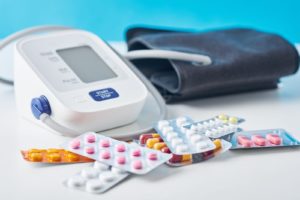
An RPM program for hypertension management can be extended to deliver more comprehensive health benefits to the patient. For instance, it can be used to steer the patient towards a weight management plan, fitness and exercise regimen, smoking cessation, healthy sleep practices, and other behavioral health approaches. The goal of RPM must be to empower patients and provide them the appropriate care at the right time, and not when their symptoms have worsened to warrant a visit to the hospital.
When the care providers and the patients focus on “why” the blood pressure levels may be high, the goal will shift to addressing the underlying causes along with treating the symptoms. A remote patient monitoring home blood pressure monitoring program enables the care team to utilize data points to identify the usual times during a day when the BP levels are higher, and then engage with the patient to identify the reasons for those surges.
For instance, the patient’s diet, exercise, stress levels, lack of hydration, or non-compliance with medications may be contributing to the cause of their high blood pressure. Data analysis along with a discussion with the patient can help a healthcare provider connect the dots and make more effective recommendations.
Patient education is one of the important benefits of an RPM home BP monitoring program. When the patient sees hard data about changes in their BP levels correlated to their lifestyle and behaviors and medication adherence, it can convince them to exercise greater restraint and make healthier lifestyle choices.
If the remote patient monitoring program identifies that high BP readings occur after stressful events in the patient’s workplace or household, they can be encouraged to learn stress management techniques such as yoga and meditation. If the BP fluctuations appear to originate from the patient’s dietary choices, they can focus on scientific diet management.
Once the healthcare organization discovers the outstanding benefits of their RPM program for hypertension diagnosis and management, they may be prepared to add more RPM devices and obtain more data to enhance patient care. For instance, adding an RPM weight scale to the program can help maintain a better track of the patient’s body weight and fitness, which might be correlated to their symptoms of hypertension.
Remote patient monitoring programs can serve the larger goal of creating a collaborative approach to hypertension management. In these types of conditions, where the patient’s lifestyle, diet, exercise, work, stress levels, and behavioral choices play an important role, the patient’s cooperation and commitment are important. An RPM program that focuses on communication and engagement with patients, apart from data-driven blood pressure management, can produce more effective results and excellent patient satisfaction rates.
HealthSnap is Defining the Future of Blood Pressuring Monitoring – Now!
Hypertension can lead to serious health concerns related to the heart, kidneys, and other vital organs. HealthSnap’s cellular blood pressure monitors should be a part of every proactive RPM hypertension management program to prioritize patient health and improve clinical outcomes. Home blood pressure monitoring provides actionable BP data obtained under pre-determined conditions and timeframes over an extended time period. This ensures more stable and accurate mean values and high reproducibility.
HealthSnap’s cellular blood pressure monitor can increase the prognostic value of your RPM program to identify cardiovascular risks in patients and ensure better hypertension management. The device is cost-effective, easy to incorporate into a patient’s daily routine, and is designed to provide reliable and accurate BP readings.
HealthSnap’s recent webinars on home blood pressure monitoring and How to Remotely Manage Uncontrolled Hypertension on the subject entailed a deep dive discussion on the future of blood pressure monitoring and why home monitoring is the gold standard for hypertensive patients. The webinar addressed the reasons why home-based ambulatory measurements are more reliable and why in-office measurements are not reliable for hypertension diagnosis and management.
To learn more about how HealthSnap can help your organization achieve its RPM goals, call us at 888-780-1872 or schedule a personalized RPM consultation for your practice!




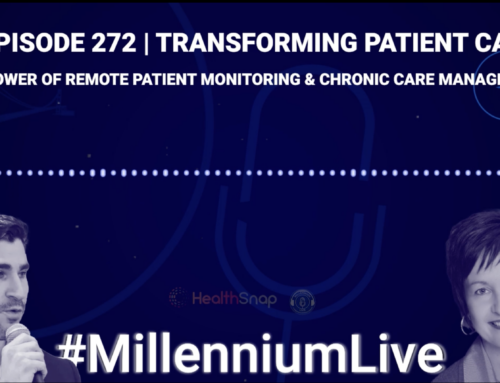







Leave A Comment
You must be logged in to post a comment.